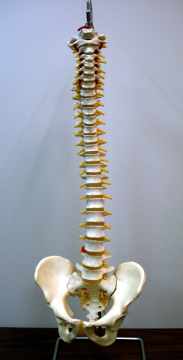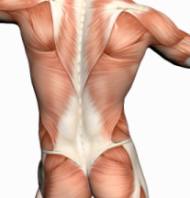|
|
||
|
Home |
Best Abs Book |
Best Ab Exercises |
Abdominal Ball Exercises |
Abs Exercise Tips |
Abs for Sports |
Pregnancy & Abs |
Yoga |
Pilates |
Flat Stomach Diet |
Smoothie Recipes |
Weight Loss Stories |
Lose 10 Pounds |
Lower Back Pain |
Back Stretching Exercise |
Resources |
Free Calculators |
Site Map |
About
Anatomy of the BackUnderstanding the Basics Can Help You!Understanding the anatomy of the back may sound boring to you, but it really can help you in treating lower back pain. Once you understand the basics, you can know which positions to avoid that can aggravate your pain. Feel free to either watch the video below, read the article or do both! The Spinal ColumnThe foundation of the anatomy of the back is your spinal column. The main function of your spinal column is to protect your spinal cord. Your spinal cord connects to your brain on one end and then sends your nerves into your body on the other end. As you probably already know, if the spinal cord is damaged, as in a car accident, it can leave you paralyzed! Therefore, we have bones in our back to protect the spinal cord. 
The Bones in Your Back - VertebraeThe vertebrae are the bones in your back surrounding and protecting your spinal cord. They are like the building blocks of the anatomy of the back...sitting one on top of the other.There is a natural "s-curve" shape formed by your vertebrae. A slight inward curve at the neck as well as a slight inward curve at your lower back. This is the position the back is the strongest and least vulnerable to injury. We call this a neutral posture. Click here for more information on posture. The Discs - The Shock Absorber of Your SpineBetween each of the vertebrae are your inter vertebral discs. I think of the discs as your shock absorber of your spine, similar to the shocks of your car. The bones aren't going anywhere, but the disc is made of a jelly-like substance on the inside and a more fibrous substance on the outer edges. Because of this, the disc does tend to move around a little. Think of it like a marshmallow or balloon between two boards.The disc is one of the primary causes of lower back pain. Many people won't feel pain from their discs at first because only the outermost layer has pain sensors in it. So, you could potentially have problems with one of your discs and not even know it yet because you don't feel any pain....yet. One of the hypotheses from the anatomy of the back for why the disc causes lower back pain is as follows. When you bend forward, the bones come together in the front, pushing the disc further backward. This normally won't cause pain, but after repeatedly bending over for years or sitting with a bent over or slouched posture for long periods of time the hypothesis is that the disc moves further backward putting pressure on the nerves. The Spinal NervesAt each vertebral level, a nerve exits through the bone. The interesting thing to note, is that each nerve is located very close to the disc at that same level. Remember, the nerve originates from the spinal cord and then from your neck goes into your arms and from your lower back goes into your legs. That is why sometimes people will have pain, numbness and tingling in their legs when it originates from their back. Let's say that a disc begins to move further backward from repetitive bending forward and prolonged slouched sitting. Over time, it could eventually bulge backward until it touches the nerve. That's when your pain will increase and possibly even go into your legs. Note that the disc is not the only cause of lower back pain. You can also have muscle spasms, stenosis (narrowing of the spinal column putting pressure on the nerves), compression fractures from osteoporosis and even things as serious as tumors and cancer. That's why it's important to see a health care provider if you are having lower back pain. Anatomy of Back Muscle Finally, covering your spinal column, nerves and discs are your ligaments and muscles. Ligaments attach bone to bone and muscle attaches to the bone through tendons. You have some pretty big muscles in your back called the paraspinals and then you also have some smaller muscles for posture.
Finally, covering your spinal column, nerves and discs are your ligaments and muscles. Ligaments attach bone to bone and muscle attaches to the bone through tendons. You have some pretty big muscles in your back called the paraspinals and then you also have some smaller muscles for posture.How Anatomy of the Back Impacts YouSo, if you want to try to prevent back pain or limit aggravating symptoms in your lower back it will be important to try to limit repeated forward bending and prolonged slouched sitting. Research has found that forward bending with your legs straight puts 7-10 times the pressure on your lower back. While sitting slouched puts twice as much pressure on your lower back that sitting with good posture. Twisting at the spine also compressed the disc, placing more pressure on it.Positions to avoid:
Remember, this is the general rule and will not apply to every single person. Also Recommended for Treating Lower Back Pain...Click here for more information about "Healthy Back Workouts"Try the press up exercise, one way to do yoga for lower back pain. Return from Anatomy of the Back to Abs Exercise home page.
Home |
Best Abs Book |
Best Ab Exercises |
Abdominal Ball Exercises |
Abs Exercise Tips |
Abs for Sports |
Pregnancy & Abs |
Yoga |
Pilates |
Flat Stomach Diet |
Smoothie Recipes |
Weight Loss Stories |
Lose 10 Pounds |
Lower Back Pain |
Back Stretching Exercise |
Resources |
Free Calculators |
Site Map |
About
|
Download 21 Free Abs ExercisesEnter your name and email address here to get your free download: The ABS Lady Recommends: |
|
|
|
||
|
Best Abs Book | Contact | Disclaimer | Privacy Policy Copyright © 2004-2013 Abs-Exercise-Advice.com - All Rights Reserved. Return to top |
||